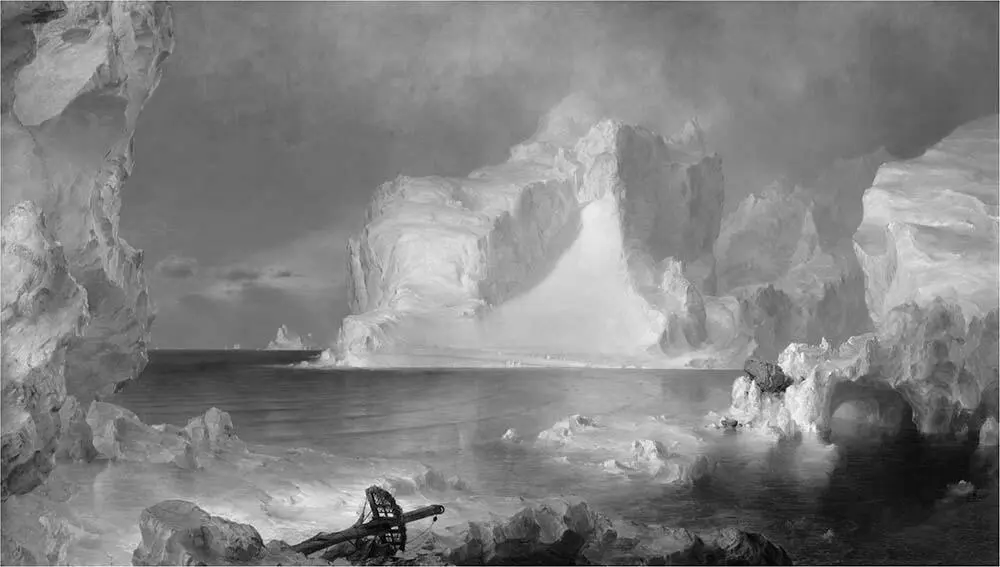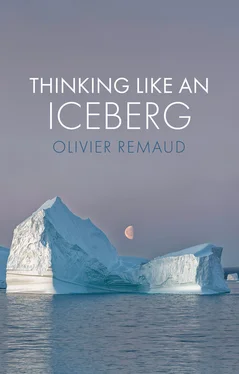This episode with the group of icebergs changes the fate of our narrator. Nothing is really the same any more. The rest of the journey is a chaos of images. The more he crosses paths with other behemoths, the more Noble forges new ones to illustrate the encounters: a warship with pointed cannons and a sharp bow, ivory carvings, clouds depicting the faces of poets, philosophers or polar bears. He describes caves, niches, balconies and escarpments. He guesses that the icebergs cast a melancholy gaze on the ship’s passengers. He is saddened by the way some are obviously fragile. Meanwhile, on deck, Church finishes his preparatory oil studies. Then, in his cabin, he pencils a few sketches on the pages of a small notebook and carefully arranges his boxes.
Two years after their return, the painter unveils an impressive work to the New York public: The North . The painting is 1.64 m by 2.85 m. It is April 1861, opinion was positive, but not unanimous: too much emptiness, no signs of humans. Church reworked his large canvas. He decided, on the spur of the moment, to show it in Europe. In June 1863, an evening for the launching was organised in London. A number of prominent people attended, including Lady Franklin and Sir Francis Leopold McClintock. Observers in the British capital could see a broken mast, still with its masthead, pointing to a boulder on the right. Church added the detail in the final version. No doubt to evoke the tragic sinking of the Franklin and as a reply to his critics. All around the icebergs there is the same veiled Arctic glow. The painter renamed his work with the title it still bears: The Icebergs .
What reading can we give this painting?
A text printed on a sheet of paper was distributed when it was presented, in 1862, at the Athenaeum in Boston. In it, the artist explains his choice of perspective. He addresses the audience:
The spectator is supposed to be standing on the ice, in a bay of the berg. The several masses are parts of one immense iceberg. Imagine an amphitheatre, upon the lower steps of which you stand, and see the icy foreground at your feet, and gaze upon the surrounding masses, all uniting in one beneath the surface of the sea. To the left is steep, overhanging, precipitous ice; to the right is a part of the upper surface of the berg. To that succeeds a inner gorge, running up between alpine peaks. In front is the main portion of the berg, exhibiting ice architecture in its vaster proportions. Thus the beholder has around him the manifold forms of the huge Greenland glacier after it has been launched upon the deep, and subjected, for a time, to the action of the elements – waves and currents, sunshine and storm.

Figure 1 Frederic Edwin Church, The Icebergs (1861–3), Dallas Museum of Art
Church trains the viewer’s eye by detailing aspects of the scene. He believes that the audience needs this. For at least two reasons. On the one hand, the iceberg is a spontaneously pictorial object. But the variety of its lines must be shown. Otherwise, the viewer risks becoming bored with so much uniformity. On the other hand, the beauty of the iceberg is intriguing. The proportions of the iceberg throw Archimedes’ principle into doubt. The mass seems very heavy. And yet it floats! It is so light, almost airy. How can the combination of weight and weightlessness be represented?
The painter has observed the bergs closely. He knows that their plasticity is a challenge. Their straight lines intertwine and their curves overlap. The icebergs constantly alternate foregrounds and backgrounds. They compose volumes that seem eternal. Then they dissolve into the air and the ocean. The massive ice cubes metamorphose into small balls of volatile flakes.
Church wants to control these ambivalences. He directs the gaze into a well-defined space. Better still, he plays with the frame, making the ice occupy three sides of the painting. He freezes the icebergs in their materiality and makes a stationary image from an inanimate, hieratic world that is ice in every direction, except for on high, where it opens onto a horizon tinted with the sun of a peaceful late afternoon. This framing of ice by ice, saving one side for the source of the light, has only one purpose: to make the spectators understand that the real texture of icebergs is that of light. In the eyes of the painter, it is light that reshapes the forms.
A boulder can be seen on the right-hand side of the painting. This is not an aesthetic whim. The art historian Timothy Mitchell has shown that Church was taking a stand in a scientific controversy between Louis Agassiz and Charles Lyell from 1845 to 1860. The debate between the two scientists centred, among other things, on the exact nature of ‘erratic’ rocks and the role of icebergs.
Agassiz defended the thesis of an ancient global glaciation in his famous Études sur les glaciers and several other lectures. During a primordial ‘ice age’, the Earth was covered, and the so-called erratic boulders, which often adorn the sides of glaciers, were signs of this. Lyell proposed another theory in his no less famous Manual of Elementary Geology . On several field trips he had examined many deposits on shore that came from beached icebergs. He deduced that these alluvia corresponded to the rocky conditions of the continents. His opinion was that part of the Earth, including the North American plate, had not been covered by ice but, rather, submerged. Then as the water had receded, the continents reappeared and the icebergs had carried boulders from the land. The ‘floating mountains’ solved the riddle of rocks scattered far from any ice mass.
Lyell’s hypotheses influenced many explorers. They looked for evidence that icebergs carried pieces of rock. By the 1860s, however, empirical evidence confirmed Agassiz’s arguments. His rival eventually abandoned his theories of iceberg ‘rafts’. 5
Church’s painting has gone through several versions and many variations. Long forgotten, it is now a much prized work. It is not only a tribute to Franklin and the strange beauty of ice, it is a nod to a geological argument about the Ice Age. Off the coast of the island of Newfoundland in the summer of 1859, Noble saw icebergs as the monuments representing the whole world. The artist painted his canvases imagining that these sublime masses carried the debris of a once sunken planet.
Church went north with a mind full of books. Like most of his contemporaries, he was aware of travelogues and scientific writings. But at the forefront of his thinking were the now popular reflections of Edmund Burke and Immanuel Kant on the sublime. In these theories of the previous century, the canonical examples are those of a mountain whose snowy peak pierces the clouds, of a storm breaking, or of a storm seen from the shore. The fictional viewer experiences a paradoxical feeling of a fear of dying while remaining in safety. All five senses warn one of the risks. At the same time, one feels infinitely free. One’s reason finds strength in confronting an idea of the absolutely immense, even of the unlimited. At a safe distance, one might assume that one’s life is not really in danger.
These ideas were widely disseminated among the international community of polar explorers. Confronted with icebergs, everyone feels the same contradictory emotions as those described by philosophers when faced with raging waves, lightning in the sky or alpine snow. Adventurers are both terrified and amazed, overwhelmed and exhilarated. They rediscover their dual nature as sentient and spiritual beings. They feel both fragile and powerful, both mere mortals and true demiurges. In Church and Noble’s time, the spectacle of the iceberg was already over-coded by theories of the sublime.
Читать дальше













